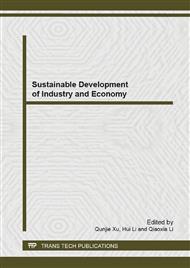[1]
Grossman, Gene M, and Elhanan Helpman: European Economic Review Vol. 35(1991), pp.517-526.
Google Scholar
[2]
Ronald I. McKinnon: The Economic Journal Vol. 74 (1964), pp.388-409.
Google Scholar
[3]
Matthews, R. C. O: Scottish Journal of Political Economy Vol20 (1973), pp.195-209.
Google Scholar
[4]
Zhang, K.H., Contemporary Economic Policy Vol. 19 (2001) , pp.175-185.
Google Scholar
[5]
Francisco Rodriguez and Dani Rodrik: NBER Macroeconomics 15(2000), pp.261-338.
Google Scholar
[6]
Moschos, D: Journal of Development Economics Vol. 30(1989), p.93–102.
Google Scholar
[7]
Sachs, J.D., Warner, A: Brookings Papers on Economic Activity Vol. 1 (1995), p.1–118.
Google Scholar
[8]
Tyler, W. G: Journal of Development Economics Vol. 9 (1981), p.121–130.
Google Scholar
[9]
Ghosh, Dipak: The Journal of Developing Areas Vol. 30 (1996), pp.167-182.
Google Scholar
[10]
Guangyao Xu: International trade issues Vol. 2(2007), P. 3-7. In Chinese.
Google Scholar
[11]
Ghartey, Edward E: Applied Economics Vol. 25 (1993), pp.1145-1152.
Google Scholar
[12]
Bonai Fan, Yibing Wang: International trade issues Vol. 4 (2004), pp.8-13. In Chinese.
Google Scholar
[13]
Jiang Du: International trade issues Vol. 4(2007), pp.9-12. In Chinese.
Google Scholar
[14]
Qiquan Xiong, Shier Yang: International trade issues Vol. 2 (2005), pp.5-10. In Chinese.
Google Scholar
[15]
Helian Xu, Mingyong Lai: Journal of Hunan University Vol. 29 (2002), pp.124-128. In Chinese.
Google Scholar
[16]
Herzer Dierk; Nowak-Lnowak-Lehmann, Felicitas D.; Siliverstovs Boriss: Developing Economies Vol. 44(2006), pp.306-328.
Google Scholar
[17]
Keller W: NBER Working Paper(1999), pp.69-90.
Google Scholar
[18]
Edwards, Sebastian: The Economic Journal Vol. 108(1998), pp.383-398.
Google Scholar
[19]
Halit Yanikkaya: Journal of Development Economics Vol. 72 (2003), p.57– 89.
Google Scholar
[20]
Jianbao Chen, Bo Dong: Engineering Vol. 29(2011) , pp.952-956.
Google Scholar
[21]
Information on http: /ssrn. com/abstract=1373882 or http: /dx. doi. org/10. 2139/ssrn. 1373882.
Google Scholar
[22]
Foster, Neil: Journal of Development Studies Vol. 42(2006), pp.1056-1074.
Google Scholar
[23]
Konya, László: Economic Modelling Vol. 23(2006), pp.978-992.
Google Scholar
[24]
Arellano, Manuel and Stephen Bond: Review of Economic studies Vol. 58 (1991), pp.277-297.
Google Scholar
[25]
Roodman, David: Center for Global Development Working Paper 103(2006) . Information on http: /ssrn. com/abstract=982943 or http: /dx. doi. org/10. 2139/ssrn. 98294.
Google Scholar


